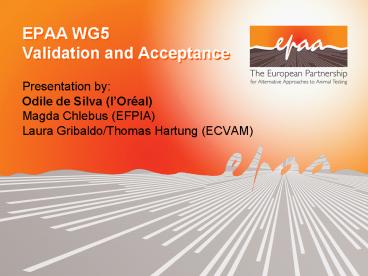EPAA WG5 Validation and Acceptance - PowerPoint PPT Presentation
1 / 22
Title:
EPAA WG5 Validation and Acceptance
Description:
GlaxoSmithKline. Henkel Phenion. Intervet. Pfizer. Unilever. Objectives of WG5 ... Criteria for prioritising studies of industry interest ... – PowerPoint PPT presentation
Number of Views:42
Avg rating:3.0/5.0
Title: EPAA WG5 Validation and Acceptance
1
EPAA WG5 Validation and Acceptance
- Presentation by
- Odile de Silva (lOréal)
- Magda Chlebus (EFPIA)
- Laura Gribaldo/Thomas Hartung (ECVAM)
2
WG5 Membership
- Activity Leaders/Co-chairs
- S. Breier DG Enterprise (Cosmetics)
- L. Gribaldo ECVAM
- O. de Silva LOréal
- M. Chlebus EFPIA
- Team Members
- AstraZeneca
- BASF
- Bayer
- Covance
- DG Enterprise (Pharma)
- DG Enterprise (Reach)
- DG Environment
- DG Sanco
- ECOPA
- GlaxoSmithKline
- Henkel Phenion
- Intervet
- Pfizer
- Unilever
3
Objectives of WG5
- To facilitate and accelerate validation of
existing methods relevant for industry use - To overcome barriers to validation and regulatory
acceptance.
4
How? Three Actions
- Support to Validation of priority methods in the
ECVAM pipeline - Criteria for prioritising studies of industry
interest - List of methods to be supported by industry with
data and substances - Procedure and timelines for provision of data and
substances - Overcoming barriers to validation
- Case studies and inventory of barriers
- Discussion document on potential solutions and
strategy - Overcoming barriers to regulatory acceptance
- Start of implementation scheduled for Q1 2007
5
Interlinkage of Working Group Activities
Map and evaluate past and current 3R activities
Identify, disseminate implement 3R best practice
Evaluation of the regulatory drivers for animal
use
Prioritise and implement research based on 3Rs
Validate and accept alternative methods and
strategies
6
WG5 Process and Timelines
Action1 Action 2 Action 3
Criteria and list of Priority studies Definition
of needs
Provision of data and/or substances
Case studies Definition of barriers Strategy
Implementation of agreed strategy
Case studies Definition of barriers Strategy
Implementation of agreed strategy
06Q3 06Q4 07Q1 07Q2 07Q3
7
Activities in 2006
8
Action 1
9
ECVAM pipeline reduction replacement
41
59
Potential for replacement within testing
strategies
10
The methods in the ECVAM pipeline for which there
is a need for data /substances
11
ECVAM and validation status
Implementation
Research
Regulatory Acceptance
Development
Endocrine modulators Systemic toxicity
24 methods
ESAC Review
Prevalidation
Carcinogenicity Eye irritation
Validation
ECVAM
Duration of the validation process 2 to 7 years
12
Prioritisation of the methods of relevance to
industrial use
- Based on an agreed list of criteria defined in
the September 2006 stakeholders workshop - Purpose to pilot a few projects with relevance
to regulatory testing and where needs are well
defined - Profiles of the prioritised methods prepared in
close collaboration with ECVAM and different
sectors experts
13
Prioritisation criteria (1)
- Ethics
- Overall (in vivo/in vitro) impact on numbers of
animals and severity, - increased level of safety
- Regulatory relevance
- Regulatory requirement,
- full replacement or tiered strategy,
- legislative timelines
14
Prioritisation criteria (2)
- Industrial incentive
- Regulatory acceptance,
- across sector applicability,
- transferability,
- frequency of use,
- applicability across a range of molecules
- Development status
- Relevant positive and negative references
response, - high advancement of the test,
- clear purpose,
- availability of data,
- relevance to the best scientific knowledge,
- high probability for success
15
Action 2
16
Barriers to validation where can the EPAA help?
17
EPAA framework for collaboration to facilitate
successful validation
- Industry contact points equipped with validation
SOPs - Standard operating procedures
- ECVAM elements to be included in an information
request - Industry how to process validators
data/substance request - Confidentiality agreement for provision of data
substances - Finalisation expected in early 2007
18
Other recommendations
- Adding a regulatory review module to the
validation process - Involvement of industry at the stage of study
design - Involvement of regulators in early stages of the
procedure to support regulatory acceptance
process - Applicability of approaches to be revisited with
regulators after 5 years in order to consolidate
the relevance of the method.
19
Suggested Expanded Modular Approach to Validation
20
Next steps and conclusions
21
Next Steps
- Reflection on
- the role of validation and assessment for
different purposes/sectors and by different
bodies - regulatory requirements vs. levels of confidence
and acceptance of the validation of methods and
strategies. - criteria and prerequisites for efficient and
robust validation as well as legal acceptance of
alternative methods and testing strategies - Promotion and fostering the regulatory acceptance
and the use of new testing strategies - Guidance on validation of strategies
- Continuous support to the validation process in
ECVAM.
22
Conclusions
- EPAA has a great potential to make the process of
validation more efficient - by enhancing the collaboration between ECVAM,
industry and regulators - in order to overcome administrative barriers and
- to ensure that priority is given to validation of
methods, which will ultimately be accepted and
used. - This unprecedented cross-sectoral dialogue is
helping to build common understanding of
different parties needs and processes - All actions on validation and acceptance have a
medium to long term perspective. Clear
milestones will help to assess progress made































